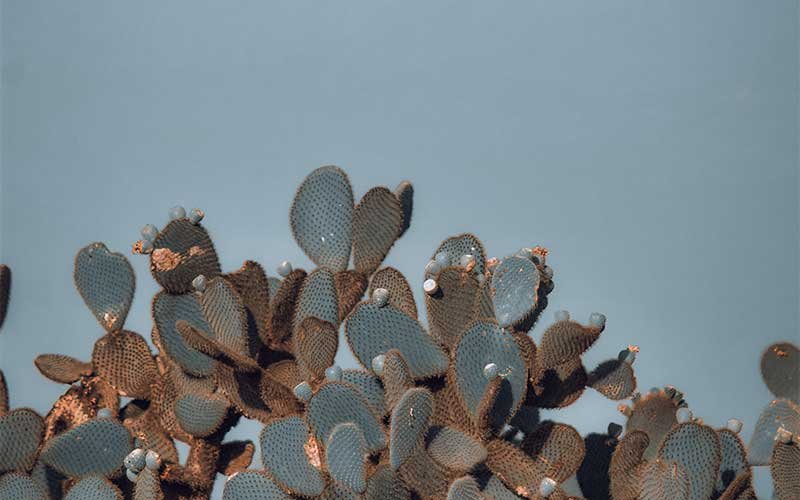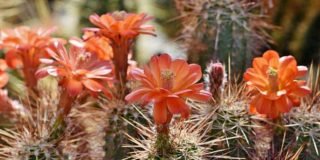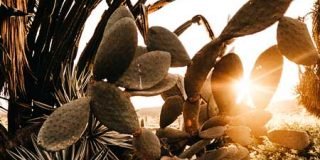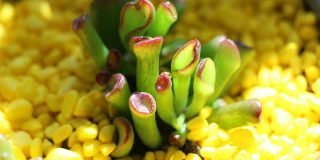Contents
Succulents have taken over the world, in fact, a lot of gardeners have joined the bandwagon and started growing succulents in their gardens, whether indoors or outdoors. Do you know that all cacti are succulents but not all succulents are cacti? You heard it right! If you are planning to grow cacti at home, in this article, we will be discussing the tips and tricks for growing blue cacti. If you are curious and you want to find out more, make sure to continue reading below!
If you are planning to grow or care for a blue cactus, Pilosocereus is the best choice for you! This variety of cacti is widely cultivated by succulent growers; there is a big chance that you will be able to find one in a garden center near you! Most cacti love full sun exposure and do not do well in cold climates.
A lot of cacti varieties have been grown for ornamental features, including the spines, shape and size, and their beautiful flowers. Some cacti are grown because of the color of the skin. Most cacti species are green, but there are blue cacti that are beautiful that can make any landscape, xeriscapes, or desert gardens stand out. Cacti come in different sizes, shapes, forms, and colors and because of that, they can be used in various garden settings and dish gardens as well.

1. Pachycereus pringlei – It is also known as Elephant Cactus. This plant’s ribs are blue-green. It is native to Northwestern Mexico and can be found in California.
2. Cholla cactus – This cactus is a fuzzy blue. It is commonly grown in the south and southwestern parts of the United States. They are known for their barbed spines so watch out! They can attach deeply on the skin, clothing, and fur!
3. Opuntia – It is also known as Prickly Pear. Some varieties of Opuntia cactus have blue skin and sometimes purple-blue. This genus has more than hundreds of species found all over America. Some species are green, but a few of them have a striking blue color which is frost hardy, so no worries of them dying out during the wintertime. Opuntia cactus, like any cacti variety, needs full sun to thrive, as they can be prone to rot.
A. Opuntia gosseliniana is a beautiful cactus that can be added to any desert landscape; it has deep turquoise pads and shades of pink and purple. This plant and the Opuntia santa-rita is the bluest among all the cacti varieties.
If you are planning to plant this cactus in your garden, you must know that it is a fast-growing species. This plant has small spines that can attach itself to your skin and can be quite hard to find and remove, so you must place it in an area where no one can accidentally brush up on it.

4. Cereus Column cactus – This cactus grows upright and has a blue-colored skin. This cactus belongs to a large genus. Some are blue and the others have bluish skin.
A. Cereus hankeanus – It is a cactus species commonly found in Brazil. It is a thin columnar cactus that grows fast. If you will grow this plant in your garden, make sure you are ready to cut it multiple times in a year.
B. Cereus hildmannianus (Uruguayensis) – This cactus is commonly found in Brazil, it is also known as Cereus pervuianus or Queen of the Night. It is one of the most commonly grown columnar cacti in the southwestern parts of the US. This cactus grows quite fast. You can grow small versions of it as they tend to keep the blue coloration than the larger ones.
C. Cereus aethiops – This cactus is a native plant commonly found in Brazil, it has black spines and a blue-green columnar body. Warning: This succulent is difficult to handle, its spines are long, thin, and sharp and can penetrate cactus gloves. Be careful when handling them! Although this plant can be added to any landscape, there is a possibility that it can grow out of control and can be difficult to remove. This plant can tolerate cold weather.
5. Browningia – This cactus belongs to a small genus from South America, The Browningia hertlingianus or also known as Azureocereus hertlingianus. It is one of the most tender cactus species out there. This cactus is a Peruvian species and has knobby columns and golden spines; its skin has powder-blue to blue-green color. This cactus can withstand cold weather; just make sure that it will have full sunlight exposure.
6. Micranthocereus estevesii – This cactus species is also known as Siccobaccatus insigniflorus. It has plenty of orange spines and it contrasts its lovely turquoise color which makes it a perfect ornamental plant. This plant is a tender species and can be affected by freezing temperatures during wintertime.
7. Ferocactus glaucescens is a blue-green cactus species and it has yellow-orange spines. It is from Mexico and does not grow very tall like the other blue cactus varieties. It is quite hardy for individuals who live in Southern California and can be considered as one of the most carefree cacti variety.
8. Melocactus – Some melocacti are green and are grown by gardeners because of their amazing cephalums. The cephalums are the flowering parts of the cactus that form a large reddish cone structure.
A. Melocactus azureus – It is also known as Turk’s Cap and Melocactus glaucescens or also known as Waxy-stemmed Turk’s Cap have blue-colored skin. They are hardy species and are considered to be the most commonly available species. This cactus species can withstand low temperatures in the upper 20 degrees Fahrenheit. They are slow-growing and will take a lot of years before they become mature.
Melocactus azureus has fine spines compared to the glaucescens. When the cephalum appears, the melocactus stops growing and further growth goes to the cephalum. The cephalum is usually white, while the others have red tops.
9. Pilosocereus – This plant is from Brazil, it is also known as Tree Cactus, and it has powder-blue skin. It is considered as one of the most popular blue cacti species available. It is commonly available and has an extreme blue color which makes it a popular choice among gardeners because of its amazing ornamental appearance.
Some of the varieties may seem fake because of their color. Pilosocereus is a cactus genus that is commonly found in South American countries such as Brazil, Mexico, and the Caribbean, it can also be found in Florida.
Pilosocereus azureus is a beautiful blue cactus native to Brazil. It has a dramatic color and can be used with green plants. The blue cactus becomes bluer when the cactus matures.
Pilosocereus is one of the most tender species of cacti. They can be easily damaged during wintertime. If they can survive the cold weather, they will not be able to avoid getting damage caused by extremely cold temperatures and they are prone to forming ugly scars caused by freeze damage. When you have this variety of cacti, make sure to use newspaper and Styrofoam cups on the top of the cacti when the cold weather comes so you can protect them from freeze damage.

How to Care for Blue Cactus?
Most of the blue cacti varieties come from Brazil. They prefer full sun exposure and are not frost hardy. When planting a blue cactus plant you must use soil that is a bit gritty and well-draining. You don’t need to feed your blue cacti; they are easy to care for and need minimal watering.
Blue cacti can be a great addition to the garden. It can stand out in a garden full of green plants. Cacti varieties have varying shapes, sizes, forms, and blooms beautiful flowers. A cactus plant is one of the most flexible plants and is capable of surviving in harsh environments.
A blue cactus is thought to have evolved to protect itself from the environment and predators. The blue skin color of the cactus may have developed to help protect the plant from extreme sun exposure or to prevent certain pests from attacking the plant. Blue plants are not commonly found in nature, so if you want blue tones in your garden, the blue cacti are the perfect solution.
General Information About Cactus Plants
If you are searching for a plant that can thrive in harsh, drought-tolerant conditions, the cactus is a perfect choice. Most cacti varieties come from areas with dry climates, they are used to surviving for long periods without rainfall.
Most gardeners prefer blue cacti because they can be used as an ornamental plant. Just make sure to provide a bright, sunny area, and you can enjoy having this amazing and easy to care for houseplants, this makes it a perfect plant for forgetful gardeners.
There plenty of varieties of cacti that you can grow. Because of their different shapes, colors, sizes, you are bound to find one that suits your personality and design style. Make sure to provide enough light so they can bloom, the flowers have different colors, white, pink, orange, red, yellow, or purple. The most common ones are the Cereus, Opuntia, Pilosocereus, Ferocactus, etc.
If you decide to care for your cactus indoors, you can place them in well-draining containers like this. You can also use grow lights. You can grow different cacti together on a tabletop or a windowsill. You can add them when creating a small indoor succulent garden. Cacti make good houseplants; just make sure to keep them in areas where pets or small children can accidentally brush up on them. Some cacti can also be used as plants in offices.

How to Grow Cactus Plants
- Cactus houseplants can grow their best when placed in a warm bright area. They need lots of direct sunlight.
- When watering your blue cacti, you can water them every two or three weeks. Do not overwater them because they are prone to rot if they stay in moist soil.
- Most cactus plants are slow growers and will not need fertilizer. If you prefer to feed them with fertilizer, you can just apply a couple of times per year. You can do it during the spring and summer months, when using a fertilizer you must follow the directions on the packaging. You can use a 20-20-20 water-soluble fertilizer. Get it here.
- Since most cacti are slow growers, there is no need to worry about pruning, only some varieties tend to grow fast and if they do, you have to prune them accordingly. Just be careful when handling the varieties with spines.

- You can grow cacti in containers outdoors, if you have a deck, patio, or balcony, as they prefer full sun, they can survive even with areas that have extremely high temperatures and they will need containers that have drainage holes. Get your containers here.
- If you live in areas that have freezing winters, you have to take your cacti indoors during wintertime. The cold can kill your cacti or if not, can leave a nasty scar from frost damage that will not go away. If you love your cactus plant, do all the necessary measures to save them from the freezing temperatures, especially if they are not the frost-hardy kind.
- If you live in areas that are preferable for growing cacti, you can plant them in a well-draining spot, like areas on top of a sunny slope or a rock garden. Avoid planting cacti where they will be exposed to moist soil. A cactus is prone to rotting if exposed to too much moisture.
- You can propagate your cacti; you can do it by using cuttings from a mature cactus plant. You can cut the top part and plant it and it will get roots. By cutting the top part of your cactus plant, you can ensure that your plant will be producing flowers.
One of the most popular blue cacti varieties is the Pilosocereus and what makes it lovely is that they have orange spines that give a contrasting effect. They are beautiful and attractive and will be a great addition to any garden.

One of the most popular blue cacti varieties is the Pilosocereus and what makes it lovely is that they have orange spines that give a contrasting effect. They are beautiful and attractive and will be a great addition to any garden.
Cuttings Purple Prickly Pear Cactus Opuntia Violacea
- Healthy, Living cactus pads (unrooted)
- Pads measure 6″-8″
- Freshly cut from healthy cactus
Pilosocereus pachycladus Specimen Cactus
- Pilosocereus pachycladus Specimen Cactus Cacti Succulent Real Live Plant
- The plant is shown in a 6 ” pot
J R Peters Jacks Classic 20-20-20 All Purpose Fertilizer
- Free Measuring Spoon Enclosed For Easy And Precise Application
- Features The Highest Safety Factor To Prevent Burning When Applied As Directed













